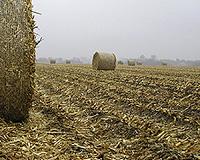 |
Reno NV (SPX) Sep 29, 201 Like the little engine that could, the University of Nevada, Reno experiment to transform wastewater sludge to electrical power is chugging along, dwarfed by the million-gallon tanks, pipes and pumps at the Truckee Meadows Water Reclamation Facility where, ultimately, the plant's electrical power could be supplied on-site by the process University researchers are developing. "We are very pleased with the results of the demonstration testing of our research," Chuck Coronella, principle investigator for the research project and an associate professor of chemical engineering, said. "The process to dry the sludge to make it burnable for a gasification process, which could then be transformed into electricity, is working very well. This is an important step for our renewable energy research, processing about 20 pounds an hour of sludge in a continuous-feed system to produce about 3 pounds an hour of dried powder." The team of researchers custom built the processing machine in a lab at the University and brought it to the plant for testing. It uses an innovative process with relatively low temperatures in a fluidized bed of sand and salts to economically produce the biomass fuel from the gooey sludge. The new patent-pending, low-cost, energy-efficient technology is an experimental carbon-neutral system. The solid fuel it produces will be analyzed for its suitability to be used for fuel through gasification, and the refrigerator-size demonstration unit will help researchers determine the optimum conditions for a commercial-sized operation. "The beauty of this process is that it's designed to be all on-site, saving trucking costs and disposal fees for the sludge," Victor Vasquez, a University faculty member in chemical engineering and collaborator, said. "It uses waste heat from the process to drive the electrical generation. It also keeps the sludge out of the landfill." Estimates, which will be further refined through the research, show that a full-scale system could potentially generate 25,000 kilowatt-hours per day to help power the local reclamation facility. The demonstration-scale project is a collaboration with the cities of Reno and Sparks, operators of the wastewater plant. The city councils signed an interlocal agreement recently to allow the research to integrate into their operation, providing space for the experiments, the dewatered sludge and other resources to help make the project a success. "Economically, this makes sense," Coronella said. "Treatment plants have to get rid of the sludge, and what better way than to process it on-site and use the renewable energy to lower operating costs. This demonstration gives the University an opportunity to involve students in development of waste-to-energy technology, which ultimately will benefit the community. It's a win-win for everyone involved." "Our next step is to do exactly what this dryer is doing on a much larger scale," he added. "We plan to demonstrate the technology at a scale 100 times larger, to convince investors and plant operators of the technology's viability." The University's Technology Transfer Office, with assistance from the College of Business, is supporting the project with plans to make the system available to hundreds of communities around the country that operate water-treatment plants. For example, there are approximately 700,000 metric tons of dried sludge produced annually in California municipalities, which would sustainably generate as much as 10 million kilowatt-hours per day. The project is funded through the Energy Innovations Small Grant Program, the California Energy Commission and the Department of Energy. This phase of the project was selected for funding by the University's Tech Transfer Office under a DOE grant to support transferring technologies from the lab to practical application. The project is one of many of the University's renewable energy research areas that have commercial potential to help Nevada's economy grow.
Share This Article With Planet Earth
Related Links University of Nevada Bio Fuel Technology and Application News
 Searching In The Microbial World For Efficient Ways To Produce Biofuel
Searching In The Microbial World For Efficient Ways To Produce BiofuelAlbany CA (SPX) Sep 29, 201 With the help of genetic materials from a cow's rumen, U.S. Department of Agriculture (USDA) scientists are developing new ways to break down plant fibers for conversion into biofuel. To convert corn stover and switchgrass into biofuel, the plant fibers must first be broken down into sugars. But cell wall polymers are cross-linked in various ways that make them very resistant to breaking d ... read more |
|
| The content herein, unless otherwise known to be public domain, are Copyright 1995-2010 - SpaceDaily. AFP and UPI Wire Stories are copyright Agence France-Presse and United Press International. ESA Portal Reports are copyright European Space Agency. All NASA sourced material is public domain. Additional copyrights may apply in whole or part to other bona fide parties. Advertising does not imply endorsement,agreement or approval of any opinions, statements or information provided by SpaceDaily on any Web page published or hosted by SpaceDaily. Privacy Statement |